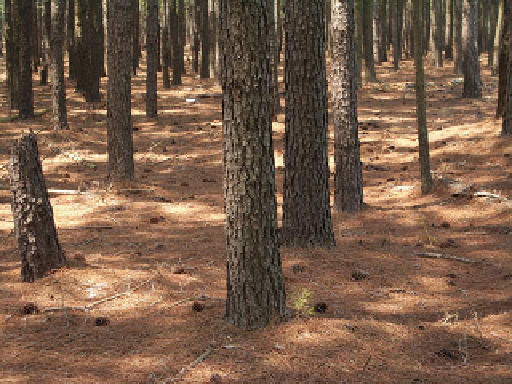Environmental Engineering Reference
In-Depth Information
use as a legal stimulant so as not to be too toxic to humans.
Nicotine sulphate (40%), however, is toxic to bees, birds,
and fish, and extracts also have been used as a pesticide. The
formation of the alkaloid nicotine is a way for plants to store
excess nitrogen as nitrogen-containing organic compounds.
Other plant-derived insecticides include the pyrethrum
esters, or pyrethrins, derived from
Chrysanthemum
cineraiifolium
, and rotenome, derived from tropical plants
such as cube barbasco and timbo and
Tephrasis virginiana
(Devil's shoestring) in the southeastern United States. The
recent marketing of such “natural” insecticides is not new;
rotenone from the root of
Derris eliptica
and pyrethrum from
Chrysanthemum cinerariaefolium
were used as insecticides
in the early 1800s. Results of recent research indicate, how-
ever, that the concentration of many natural compounds in
household cleaning may adversely affect indoor air quality;
these compounds, such as oils, react with atmospheric ozone
to produce formaldehyde.
Plants release other chemicals derived from their fixation
of carbon dioxide. They produce oils, called “essential oils,”
from glucose as an alternative way to store food for future
use. Some examples include well-known herbs, such as
peppermint, catnip, and rosemary. The oils are collected in
the cell vacuole and transported to the trichome, or modified
root hairs, on the epidermal leaf surface. Possible reasons for
the use of photosynthate to synthesis these essential oils are
as volatile pheromones used to attract pollinators or as
offensive release as protection from predators. The medici-
nal smell of the Eucalyptus tree is derived from the high oil
content in the leaves that reach the soil either during precipi-
tation or leaf fall and render the soil infertile for the seeds of
other plants to germinate.
Another type of plant oils are the terpenoids, which also
are used in many natural insecticides. Terpenes include
chemicals such as cineole and camphor (Fig.
11.10
). Terpenes
produced by pine trees and released to the atmosphere are the
primary reason that the Smoky Mountains of the southeastern
United States are smoky—the volatilized terpenes appear as a
hydrocarbon haze. In fact, the characteristic odor of freshly
mown grass is the plant's response to wounding, regardless of
whether by insects, cows, or lawnmowers, in that the grass
is essentially releasing mono- and sesquiterpenes and other
compounds. In some cases, these VOCs are thought to be
released as a signal to potential insect predators to solicit
increased predation of insect herbivores.
One of the interesting things about plants and allelopathic
potential is the role that a lack of pesticides or herbicides has
on the plants production of allelopathic compounds. This has
implications in the production of organic foods, because
organic agricultural practices are based, in part, on not
adding synthetic chemicals to the crops. Organically grown
plants, however, if besieged by pests, can produce their own
equally toxic compounds.
Fig. 11.9
This monoculture of short-leaf pines (
Pinus echinata
)in
South Carolina is caused by the root production and release of allelo-
pathic chemicals (Photograph by author).
Allelopathic compounds are produced primarily by
woody plants and perennials in arid environments where
competition for scarce water is fierce, and allelopathic
compounds have a better chance of accumulating in soils
that have low moisture content. Examples include plants
from the Genera
Salvia
and
Artemesia
. In more humid
areas, black walnut (
Juglans nigra
) produces glycoside
compounds that are inhibitory to other organisms after trans-
formation by exposure to oxygen into the active chemical
juglone. Juglone is 5-hydroxy-1,4-naphthoquinone, and it
acts to inhibit respiration in plant cells. It has low solubility
in water and, hence, stays in the soil and resists washing
from precipitation. It was long been known by farmers that it
is next to impossible to grow crops next to walnut trees. All
parts of the plant, including leaves, stems, fruit hulls, the
bark and roots release the precursor to juglone, which affects
other plant growth even after leaf fall.
Some plant-produced chemicals not only affect the
growth of other plants, but also affect the growth of plant
pests. One of the first insecticides for use on insect pests on
plants was derived from a widely used plant in the late
1800s. The compound nicotine sulphate is a contact insecti-
cide and attacks the central nervous system upon contact or
inhalation, if used as a fumigant. Nicotine is synthesized in
the roots, and is transported in the xylem in response to
insect damage to shoots and leaves. An extract of leaves in
water were used as insecticides as early as the 1690s. It is
found in the tobacco plant (
Nicotiana rustica, N. tobacum
),
which contains between 6% and 8% nicotine. This plant
derives its name from John Nicot, French ambassador to
Portugal, who sent specimens back from North America to
Europe. Native tobacco plants actually contained so much
nicotine that they had to be hybridized with tobacco plants
that contained lower nicotine concentrations for subsequent


Search WWH ::

Custom Search